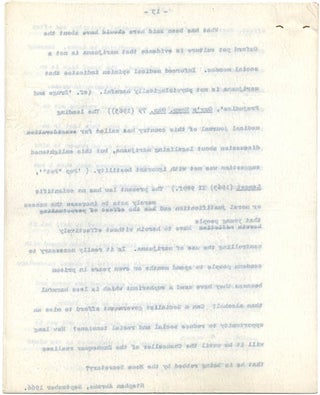1.
The Tea Break-Through.
Original typescript (carbon). Quarto, 13pp., lightweight paper stapled at top corner. Dated September 1966. Unpublished. Approximately 20 holograph amendments by the author, with a pencilled annotation preceding the title: “for The Book of Grass ed. Geo Andrews pub Peter Owen 1966”.
The text bears only a passing resemblance to the essay in “The Book of Grass” published by Peter Owen in 1966 and the Grove Press in 1967 (“The Oxford Scene and the Law”), though its subject matter, “The use of marijuana in Oxford, and in England generally”, is the same.
In this text (presumably a first draft), the title references a slang name for cannabis use, and Abrams places greater emphasis on “the ethnic tradition which gave rise to it”, employing language since outmoded: “With the massive West Indian immigration, the Englishman now lives side by side with the Negro, and finds it hard to keep up with his pretentiousness. And of course the Negro has brought his pot with him and is prepared to share it.” Another part, subsequently rewritten for the published version, describes how “pot in Oxford has been shown to work great wonders when socially retarded individuals are successfully turned on”, such as “a young Don who had previously received psychiatric treatment for several years and been forced to live on the barbiturates and amphetamines, both dangerous drugs…”.
Its final (unpublished) paragraph anticipates Abrams’ subsequent cannabis law reform petition: “The present law has no scientific or moral justification and merely acts to increase the access that young people have to heroin without effectively controlling the use of marijuana”. The author concludes by asking: “Can a Socialist government afford to miss an opportunity to reduce social and racial tensions? How long will it be until the Chancellor of the Exchequer realizes that he is being robbed by the Home Secretary?”
Almost certainly unseen since it was written in 1966, the manuscript offers an insight into the development of the author’s thinking and the sequence of events that led him to create the SOMA Research Association a few months later, culminating in the landmark advertisement it sponsored in The Times in July 1967.
 Back to top
Back to top



